Sam Borenstein: Synesthesia and the Fusion of Senses
Synesthesia comes from the Greek words: syn (together) and aesthesis (sensations).1 In 1690, the English philosopher John Locke (1632-1704) recorded the first case of synesthesia.2 Locke was perplexed by the revelation of a well-educated blind man who claimed to experience the colour scarlet while hearing the sound of a trumpet.3 Thanks to current scientific studies, synesthesia is today no longer mystified. It is an ambiguous term that can be described as a crossing, multimodal combination and confusion of senses.4 In a scientific context, synesthesia is studied as a psychological behaviour in neurology and psychology. It is the state of feeling two sensations: one from an excited region, such as the eyes, and another from a distant zone not subject to any stimulus, such as the ears.5 Synesthesia is also used as a metaphor in an artistic context. It is revealed through an artwork that endeavours to portray analogues for a particular sense, often hearing, within another, usually seeing.6 Synesthesia can also be understood as a fusion of senses that enhances and offers a more accurate depiction of reality.7
Images
fig. 1

Sam Borenstein, The Red Violin, 1948, oil on canvas, 61 x 76 cm.
fig. 2

Sam Borenstein, Painting on Mount Royal, 1949, photography.
fig. 3

Sam Borenstein, Artist at Work, 1950, oil on canvas, 91 x 76 cm.
fig. 4
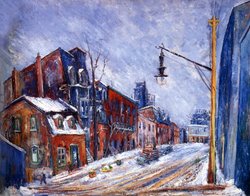
Sam Borenstein, Rue Saint-Dominique, Montreal, 1942, oil on canvas, 76.6 x 101.4 cm.
fig. 5
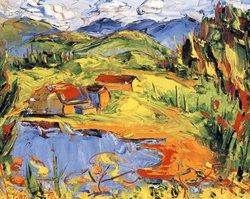
Sam Borenstein, Sainte-Lucie, Autumn, 1958, oil on canvas, 41 x 51 cm.
fig. 6
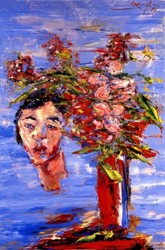
Sam Borenstein, Still-life with Face of Phyllis Webb, 1959, oil on canvas, 91 x 61 cm.
fig. 7
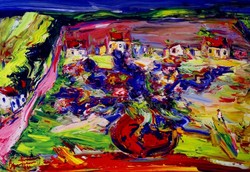
Sam Borenstein, Still-life and Landscape, 1961, oil on canvas, 76 x 102 cm.
fig. 8
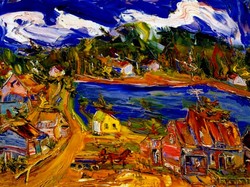
Sam Borenstein, Near Sainte-Agathe, (July 13) 1960, oil on canvas, 76.2 x 101.6 cm.
fig. 9
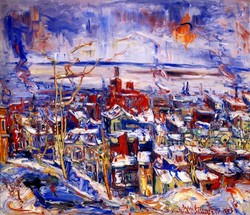
Sam Borenstein, View of Montreal, 1963, oil on canvas, 102 x 119.6 cm. Collection of the Leonard & Bina Ellen Art Gallery, Concordia University. Gift of Samuel H. Schecter Foundation. Photography: Richard-Max Tremblay.
Many well-known artists from various artistic spheres are recognized as synesthetes. The Russian artist Wassily Kandinsky (1866-1944) was said to have discovered his synesthetic abilities at a classical music concert conducted by the German composer Richard Wagner (1813-1883).8 Kandinsky wrote:
The violins, the deep tones of the basses, and especially the wind instruments at that time embodied for me all the power of that pre-nocturnal hour. I saw all my colours in my mind; they stood before my eyes. Wild, almost crazy lines were sketched in front of me.9
Later, Kandinsky started to experiment with his newly discovered synesthetic abilities by exploring the "dissonances of colour and music."10 In 1911, with the German artist Franz Marc (1880-1916), he founded an artists' group called Der Blaue Reiter (the Blue Rider). This group's goal was to explore new ideas and theories about art including painting, music and theatre.11 At this time, Kandinsky started to explore how the emotional and perceptual energies of colour, sound and dance could be presented simultaneously.12
Not only painters, several writers and musicians have also experienced synesthesia.13 The French poet and chronicler of modern life Charles Baudelaire (1821-1867) wrote poems that clearly reflect synesthetic characteristics. For example, in his sonnet Correspondances (1857) he writes: "Les parfums, les sons et les couleurs se répondent" which can be translated as: "Perfumes, sounds and colours answer each others or correspond." This passage clearly demonstrates the fusion of Baudelaire's senses of hearing, seeing and smelling. In the music domain, the Hungarian pianist and composer Franz Liszt (1811-1886), the Russian composer Nikolai Andreyevich Rimsky-Korsakov (1844-1908) and the American composer George Gershwin (1898-1937) are known to have had synesthetic abilities. For instance, Liszt saw colours when hearing tones. He was reported as saying while he was conducting an orchestra in 1842: "O please, gentlemen, a little bluer, if you please! This tone type requires it!" or "That is a deep violet, please, depend on it! Not so rose!"14 Rimsky-Korsakov perceived specific colours associated with major notes, such as sparkling sapphire with an E tone note.15
Gershwin also seemed to associate colours with music. Talking about Rhapsody in Blue (1924) he once said: "I took 'blues' and put them in a large and more serious form."16 Synesthesia is a physical reality that people have but in most cases do not know what it is. In a certain way, all of us have it, some more than another, but we may not be conscious of it.
When one looks at Sam Borenstein's canvases, one sees more than an image. Borenstein's paintings evoke movement, texture, and composition. Moreover as I will demonstrate in this essay, music can be perceived in his paintings. Borenstein, born in Lithuania in 1908, immigrated to Montreal in 1921 where he was actively engaged in painting until his death in 1969.17 Borenstein was very found of music and nature. How does synesthesia manifest itself in Borenstein's paintings? Even though there is no way to prove without any doubt that Borenstein had synesthetic abilities, with the evidence we have, one can assume that he possessed them or, at least, his art suggests synesthesia. I will examine a selection of Borenstein's artworks as synesthetic in relation to the artist's fusion of colour with other senses, especially the sense of hearing music.
Music is a key element in Borenstein's art practice. As a child, he dreamt of becoming a musician. This dream stopped because of the First World War.18 The Red Violin (1948) refers to this moment of Borenstein's childhood when his violin teacher left the country because of a pogrom (fig.1).19 However, music never left Borenstein's side. In an interview, his daughter, the animator and documentary filmmaker Joyce Borenstein, said that her father was fond of classical music.20 Ludwig van Beethoven (1770-1827) and Frédéric-François Chopin (1810-1849) were among his favourite composers.21 As well, Borenstein especially liked the symphonic suite Scheherazade Opus 35 (1888) by Rimsky-Korsakov.22 He was also enthusiastic about the Rhapsody in Blue by Gershwin with its Jazz overtones.23 Joyce remembers that her father often listened to classical music while he was painting. Also, it is possible that even though Borenstein was not listening to music when he painted outdoors, he carried the music in his memory (fig. 2). When working in his studio at home, Borenstein often repeated the same musical piece until his painting was completed. Thus the mood, feeling, and movement of a musical composition were connected with the image he was creating.24 Before he took a stroke with his brush, he poised for a moment. He would concentrate on the music, stare at the blank canvas and shake his hand holding the brush near the surface of the canvas.25 The brush would be "pregnant, full of energy."26 He would rehearse the sweep and direction of the movement he was about to paint and wait until he was really sure where to start the stroke and how fast it would progress. As he portrayed himself in Artist at Work (1950) the artist is like a maestro who directs musicians with his baton in an orchestra, as he composes his canvas with brushes and paint (fig. 3).
While the sense of music is paramount in Borenstein's painting process, his works do not only involve musical hearing. When Borenstein was painting outdoors scenes, he wanted to fully experience nature by feeling the heat or cold. Painting winter night scenes such as Rue Saint Dominique, Montreal (1942) he did not wear gloves (fig. 4). He did not want the gloves to interfere with his movements. He wanted to feel the cold and paint it.27 By feeling the cold, Borenstein was able to understand it and encapsulate it on the canvas by means of the brushstrokes and coloured textured that he used. Like a musician, his body and movements moved along with his experience of nature. The musician plays not only to generate sounds, but to receive feelings.28 Borenstein, like a musician, is not only producing a painting of a specific scene, he is also receiving the perceptions of this scene, such as the tactile senses of heat or cold.
Moreover, Borenstein painted what he saw: not as an image, but as an experience. Hence, the colours he uses highlight his own reactions to the scene he decides to paint. For example, Sainte Lucie, Autumn (1958) is an explosion of rich colours, wind movement, and the ebb and flow of natural elements (fig. 5). It does not represent faithfully what the landscape really looked like. Rather, it is faithful to the essence of the scene: the artist's encounter with nature. To be able to capture the scene before him, Borenstein appeared to be in a trance-like state for several hours, not taking any breaks.29 Only when his painting was finished, would he sit back and look at his work like a musician reviewing his performance once it has ended. Borenstein could have been experiencing synesthesia through a multi-modal combination of senses, submerged as he was in sounds, smells, rhythm and vibrancy of nature.
An artist's choice of subject matter can reflect his synesthetic sensibility. Borenstein fused together different painting genres.30 Still-life with Face of Phyllis Webb (1959) is a portrait hanging on a vase of flowers (fig. 6). Still-life and Landscape (1961) is another example of Borenstein's attempt to combine different genres by depicting a still-life overlapping a landscape (fig. 7). With these paintings Borenstein challenges not only artistic conventions, but also the viewer's perceptions. This blend of genres can be understood as the concept of synesthesia.
In Borenstein's paintings paths and roads leading to a place beyond the painting's frame are a recurrent element. This has the effect of inviting the viewers into the painting. This too can be understood within a synesthetic context since the viewer following along the path is invited to feel and experience the painting's surface, composition and formal elements. In Near Sainte Agathe (1960) our eyes first focus on the farmhouse's red roof situated on the painting's bottom right hand side (fig. 8). Our gaze works its way horizontally where the road starts next to the brownish colours of the farm's soil. Then our eyes encounter the carriage drawn by two horses. We hear, or at least imagine hearing the horseshoes resonate as they hit the ground. We follow the road's textured pathway enriched by the play of light on the painted surface. Our eyes touch the path's uneven surface on the left hand side of the painting. We then see the mustard-yellow house and the greenish-blue water. We also taste the fresh green trees whose odour reminds us of late summer days. Our multi-sensorial discovery of the scene ends up when we come upon the white clouds and the deep blue sky moving along with the wind. We experience not only a variation of rich and lively colour, we are also transported into the vibrant brush strokes and varied textures. Journeying along the road, this landscape stimulates our senses by encouraging us to perceive colours, wind, light, texture, odour and the overall scene's energy which Borenstein himself sensed while painting this work.
I will conclude this essay by discussing the connection between a musical composition and a painting. Rhapsody in Blue merges music and art in its title which refers to the colour blue. When one looks at View of Montreal (1963) while hearing Rhapsody in Blue, the painting's formal elements become alive with music (fig. 9). View of Montreal resembles a musical piece such as Rhapsody in Blue has in how the various parts are united together to form a work of art. The painting's foreground may evoke the clarinet solo introduction of Rhapsody in Blue. The clarinet sets in motion the painting's rhythm and introduces its tonality. Then the viewer's eyes move into the painting's middle ground where they discover Montreal's buildings. The middle ground can be understood as the equivalent of Rhapsody in Blue when the entire orchestra plays. The urban landscape explodes with vivid colours that echo the foreground's brushstrokes. For example, the smoke coming out of the chimneys have a certain musical form, dancing along with the winter's wind. The Saint Lawrence River and the sky occupy the painting's background. This part of the painting can be understood as a parallel to Rhapsody in Blue's piano solos which are filled with improvisational overtones and a mixture of themes. The sky and the river are similarly accentuated with Borenstein's colour improvisations. Borenstein highlights the orange round sun with a spontaneous blue circle while the horizon line is portrayed with a simple blue line.
Comparable to Rhapsody in Blue's instrumentation of musical harmony, View of Montreal demonstrates unity through its general style, composition, colour and light. The fore, middle and back grounds different from one another in terms of imagery, dominance of colours and brush strokes, are united in the painting's overall composition.
The correspondence between Rhapsody in Blue and View of Montreal serves to suggest a better understanding of Borenstein's paintings and his connection to synesthesia. Borenstein may not have listened to Rhapsody in Blue while painting View of Montreal but he understood the principles that underscored the relation of music and art. Borenstein's synesthetic abilities correlate with music and encourage the viewer to also sense these synesthetic perceptions.
Endnotes
1 Ossian Ward."The Man who Heard his Paintbox Hiss," Telegraph.co.uk, posted June 10, 2006, http://www.telegraph.co.uk/arts/main.jhtml?xml=/arts/2006/06/10/bakandinsky10.xml (accessed November 7, 2007).
2 Ibid.
3 Ibid.
4 Jean-Pierre Ternaux, "Synesthesia: A Multimodal Combination of Senses," Leonardo 36, no. 4 (2003): 321.
5 Ibid.
6 Michael Betancourt, "A Taxonomy of Abstract Form Using Studies of Synesthesia and Hallucinations," Leonardo 40, no.1 (2007): 59.
7 Ibid, 61.
8 Crétien van Campen, "Synesthesia and Artistic Experimentation," Psyche 3, no.6 (1997),
http://psyche.cs.monash.edu.au/v3/psyche-3-06-vancampen.html (accessed November 9, 2007).
9 Wassily Kandinsky, "Reminiscences," Kandinsky: Complete Writings on Art, ed. K.C. Lindsay and P. Vergo, (London: Faber & Faber, 1982), 364.
10 Crétien van Campen, "Synesthesia and Artistic Experimentation."
11 Adrienne Girling, Der Blaue Reiter (1911-1914), Dalhousie University, http://myweb.dal.ca/agirling/derblauereiter.html.
12 Wassily Kandinsky and Franz Marc. "The Blaue Reiter Almanac," Kandinsky: Complete Writings on Art, ed. K.C. Lindsay and P. Vergo, (London: Faber & Faber, 1982), 229-233.
13 Moreover, the American painter and sculptor Carol J. Steen has written an article on her synesthetic perceptions: Visions Shared: A Firsthand Look into Synesthesia and Art, 2001. She explains how she sees colours and shapes when her eyes are shut. She also sees forms and colours when she is stimulated by loud sounds or intense feelings. Steen exteriorises theses visions, also called photism, by painting them. On some occasions, Steen feels waves passing through her body. Furthermore, she explains that she has synesthetic perceptions that occur from pain, taste, smell, sound and touch. For instance, when she touches or feel something she would see specific colours and forms. Also, when there is an absence of sound, she sees white.
14 Friedrich Mahling, "Das Problem der 'Audition colorée: Eine Historische-Kritische Untersuchung," Archiv für die Gesamte Psychologie, (Leipzig: Akademische Verlagsgesellschaft M.B.H., 1926), 230.
15 John Harrison, Synaesthesia: The Strangest Thing, (Oxford: Oxford University Press, 2001), 123.
16 Edward Jablonski, "Gershwin on Music," Musical America 83 (July 1962), 34.
17 Ibid.
18 David Howes, "Crossing Sensations: Synesthesia in the Paintings of Sam Borenstein and Remedios Varo," (lecture presented at De Sève Cinema, Concordia University, Montreal, July 6, 2005).
19 Loren Lerner, "Sam Borenstein," Sam Borenstein, (Montreal: Montreal Museum of Fine Arts, 2005), 51.
20 Interview with Joyce Borenstein, Montreal, October 24, 2007.
21 David Howes, "Crossing Sensations: Synesthesia in the Paintings of Sam Borenstein and Remedios Varo."
22 John Harrison, Synaesthesia: The Strangest Thing, 123.
23 Interview with Joyce Borenstein.
24 Ibid.
25 Ibid.
26 Ibid.
27 David Howes, "Crossing Sensations: Synesthesia in the Paintings of Sam Borenstein and Remedios Varo."
28 François Delalande, "Sense and Intersensoriality," Leonardo 36, no.4 (2003), 314.
29 Interview with Joyce Borenstein.
30 David Howes, "Crossing Sensations: Synesthesia in the Paintings of Sam Borenstein and Remedios Varo."
Bibliography
Baudelaire, Charles Pierre. "Correspondances." Les fleurs du mal: poésie. Edited by
Frédéric de Scitivaux. Paris: Larousse-Bordas/HER, 1999.
Betancourt, Michael. "A Taxonomy of Abstract Form Using Studies of Synesthesia and
Hallucinations." Leonardo 40, no.1 (2007): 59-65.
Campen, Crétien van. "Synesthesia and Artistic Experimentation." Psyche 3 no. 6
(November 1997), http://psyche.cs.monash.edu.au/v3/psyche-3-06-vancampen.html.
Delalande, François. "Sense and Intersensoriality." Leonardo 36, no.4 (2003), 313-316.
Girling, Adrienne. Der Blaue Reiter (1911-1914). Dalhousie University.
http://myweb.dal.ca/agirling/derblauereiter.html (accessed November 22, 2007).
Harrison, John. Synaesthesia: The Strangest Thing. Oxford: Oxford University Press,
2001.
Howes, David. "Crossing Sensations: Synesthesia in the Paintings of Sam Borenstein and
Remedios Varo." Lecture presented at De Sève Cinema, Concordia University, Montreal, July 6, 2005.
Jablonski, Edward. "Gershwin on Music." Musical America 83 (July 1962), 32-35.
Kandinsky, Wassily. "Reminiscences." Kandinsky: Complete Writings on Art. Edited by
K.C. Lindsay and P. Vergo. London: Faber & Faber, 1982.
Kandinsky, Wassily and Franz Marc. "The Blaue Reiter Almanac," Kandinsky:
Complete Writings on Art. Edited by K.C. Lindsay and P. Vergo. London: Faber & Faber, 1982.
Lerner, Loren. "Sam Borenstein." Sam Borenstein. Montreal: Montreal Museum of Fine
Arts, 2005, 37-97.
Mahling, Friedrich. "Das Problem der 'Audition colorée: Eine Historische-Kritische
Untersuchung." Archiv für die Gesamte Psychologie. Leipzig: Akademische Verlagsgesellschaft M.B.H., 1926.
Ternaux, Jean-Pierre. "Synesthesia: A Multimodal Combination of Senses." Leonardo 36
no. 4 (2003): 321-322.
Ward, Ossian."The Man who Heard his Paintbox Hiss." Telegraph.co.uk.
http://www.telegraph.co.uk
Interview with Joyce Borenstein. Montreal, October 24, 2007.